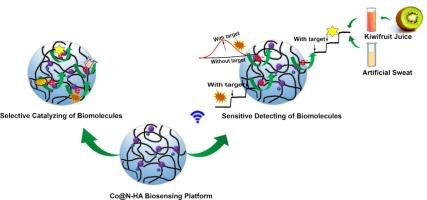在腐植酸上负载工程Co-N活性位点的电化学生物传感器,用于催化和检测生物分子
IF 4.9
2区 化学
Q1 CHEMISTRY, ANALYTICAL
引用次数: 0
摘要
腐植酸(HA)是一种天然有机物质(NOM),具有高生物相容性、低毒性和抗氧化特性,非常适合作为捕获、结合、催化和检测多种生物分子的生物传感界面。然而,由于透明质酸固有的导电性差,导致其电化学催化和生物分子检测的研究很少。本研究的重点是氮掺杂HA (N-HA)负载的Co-N活性位点,主要研究了它们对各种生物分子的电化学催化性能和对特征生物分子的生物传感能力。氮掺杂和Co负载都增加了HA的表面积,增强了电导率,促进了电子转移,提高了检测灵敏度。设计的Co-N活性位点具有选择性催化多巴胺(DA)、抗坏血酸(AA)、尿酸(UA)和5-羟色胺(5-HT)等多种生物分子的能力,提高了其抗干扰性能。基于Co@N-HA开发的生物传感器具有极低的催化电位(DA为0.20 V, AA为0.25 V)、宽线性范围、低检出限(AA为1.03 μM, DA为1.21 μM)和低定量限(loq为3.40 μM, AA为4.03 μM)、高重复性和高稳定性。生物传感器能够在生物液体中进行可靠的目标检测,包括人工汗液和猕猴桃汁,具有高选择性和高灵敏度,具有实际应用的稳健性。本工作拓展了透明质酸在电化学生物传感领域的应用。本文章由计算机程序翻译,如有差异,请以英文原文为准。

An electrochemical biosensor with engineered Co-N active sites loaded on humic acid for catalyzing and detecting of biomolecules
Humic acid (HA), a natural organic matter (NOM), exhibits high biocompatibility, low toxicity and antioxidant properties, making it highly suitable as a biosensing interface for capturing, binding, catalyzing and detecting diverse biomolecules. However, the inherently poor conductivity of HA has resulted in very few studies on its electrochemical catalysis and detection of biomolecules. This study focused on the Co-N active sites supported on nitrogen-doping HA (N-HA), primarily investigating their electrochemical catalytic performance towards various biomolecules and biosensing capability for characteristic biomolecules. Both N doping and Co loading on HA increased surface area, enhanced conductivity, promoted electron transfer, and boosted detection sensitivity. The engineered Co-N active sites possessed the capability to selectively catalyze diverse biomolecules including dopamine (DA), ascorbic acid (AA), uric acid (UA) and 5-hydroxytryptamine (5-HT), which improved the anti-interference property. Developed biosensor based on Co@N-HA achieved sensitive detecting of DA and AA with the extremely low catalyzing potentials (0.20 V for DA, 0.25 V for AA), the wide linear ranges, the low limits of detection (LODs, 1.03 μM for AA, 1.21 μM for DA) and limits of quantification (LOQs, 3.40 μM for AA, 4.03 μM for DA), accompanied by high reproducibility and stability. Biosensor enabled reliable target detection in biological fluids, including artificial sweat and kiwifruit juice, with high selectivity and sensitivity, declaring its robustness for practical applications. The work expanded the application of HA in electrochemical biosensing field.
求助全文
通过发布文献求助,成功后即可免费获取论文全文。
去求助
来源期刊

Microchemical Journal
化学-分析化学
CiteScore
8.70
自引率
8.30%
发文量
1131
审稿时长
1.9 months
期刊介绍:
The Microchemical Journal is a peer reviewed journal devoted to all aspects and phases of analytical chemistry and chemical analysis. The Microchemical Journal publishes articles which are at the forefront of modern analytical chemistry and cover innovations in the techniques to the finest possible limits. This includes fundamental aspects, instrumentation, new developments, innovative and novel methods and applications including environmental and clinical field.
Traditional classical analytical methods such as spectrophotometry and titrimetry as well as established instrumentation methods such as flame and graphite furnace atomic absorption spectrometry, gas chromatography, and modified glassy or carbon electrode electrochemical methods will be considered, provided they show significant improvements and novelty compared to the established methods.
 求助内容:
求助内容: 应助结果提醒方式:
应助结果提醒方式:


